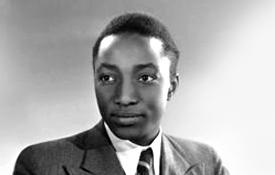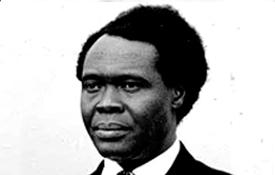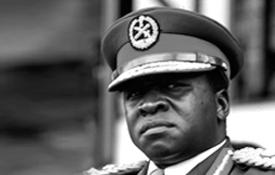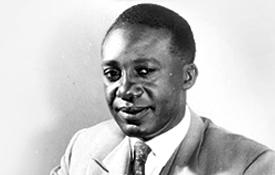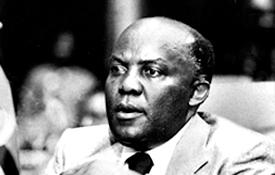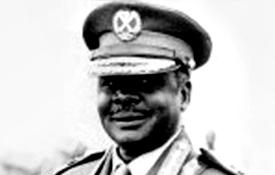Sir Edward Luwangula Walugembe Muteesa II was the first post-independence President of Uganda. Muteesa was born at the house of Sir Albert Cook in Makindye, Kampala, on 19 November 1924, the fifth son of Sir Daudi Chwa II, Kabaka of Buganda, who reigned between 1897 and 1939. His mother was Lady Irene Drusilla Namaganda.
At the age of five, his father took him in one of the best schools at the time, Kings College Buddo. He took him to live with the then Headmaster of the college, Rev. H.M Grace.
At the age of fifteen, upon the death of his father on 22 November 1939, he was proclaimed Kabaka, and was installed outside the Lubiri at Mengo on 26 November 1939. Thereafter he reigned under a Council of Regents until he came of age and assumed full powers.
He then went to England to complete his education at Magdalene College, Cambridge, where he joined the Officer Training Corps and was subsequently commissioned as a captain in the Grenadier Guards. He was to rise through the ranks of the grenadiers to become a Major General. He was the only black officer in the Grenadiers.
But at home, the Kabaka faced even larger challenges. The fight for self-determination was taking center stage. The years between 1945 and 1950 saw widespread protests against both the Governor of Uganda’s and King Muteesa’s governments. Some of the Baganda thought that Muteesa was not so tough against the British and that some of his ministers including S.W Kulubya, then in charge of finance were ‘stooges’ of the British. Kulubya, who survived mob justice, was forced to resign hours later.
In the early 1950s the British Government floated the idea of uniting British East Africa (Uganda, Kenya and Tanganyika) into a federation. East Africans feared that this would lead to their coming under the control of Kenya’s white settler community. The Baganda, fearing they would lose the limited autonomy they had under British rule, were vehemently opposed. Muteesa himself opposed the proposal, and thus came into conflict with the British Governor, Sir Andrew Cohen.
In 1953, the Lukiiko sought independence from Uganda, with Muteesa himself demanding that Buganda be separated from the rest of the protectorate of Uganda and transferred to Foreign Office jurisdiction.
Cohen’s response was to depose and exile the Kabaka. After two years of Buganda hostility, Cohen was forced by Baganda to reinstate the Kabaka. He returned to an ecstatic Kampala on 17 October 1955 under a negotiated settlement, the Namirembe which made him a constitutional monarch and gave the Baganda the right to elect representatives to the kingdom’s parliament, the Lukiiko. Muteesa’s standing up to Cohen greatly boosted his popularity in the kingdom.
The momentum was now moving towards independence and Buganda, led by Muteesa was not to be left behind. Buganda wanted her position made clear in Independent Uganda and this was Muteesa`s standing point. A constitutional meeting was held in London in 1961. According to Muteesa in his memoirs, the talks were successful for Buganda. With Obote`s support, Buganda obtained a great deal of what she wanted. But of course, Obote`s support did not come for nothing. He also wanted to be supported for the post of Prime Minister. Buganda did this by allowing its flag party, Kabaka Yekka to ally with Obote`s UPC to defeat DP in the subsequent independence elections.
In 1962 Uganda became independent from Britain under the leadership of Milton Obote. Under the country’s new constitution, the Kingdom of Buganda became a semi-autonomous part of a new Ugandan federation. Obote became the Prime Minister, while Muteesa became the first ever President of Uganda.
Unfortunately conflict was the order of the day between UPC and Kabaka Yekka. It was therefore no surprise when it collapsed chaotically in September 1964. Members of K.Y in the National Assembly were crossing to UPC, lured by the chance of office.
The Buganda regional Parliament passed a resolution in May 1966 declaring that Buganda`s incorporation into Uganda had ended with the suspension of the constitution and requesting the federal government to vacate the capital city, which was in Buganda.
Obote responded with an armed attack upon the King’s palace. Obote was triumphant so, he thought, as Muteesa fled to the UK. A year later, a new constitution that abolished traditional rulers in Uganda was promulgated.
Muteesa died of suspected alcohol poisoning in his London flat in 1969. Identified by the British police as suicide, the death has been viewed as assassination by agents of the Obote regime. Muteesa’s body was returned to Uganda in 1971 after the overthrow of Obote and given a state funeral at Kasubi Nabulagala.


